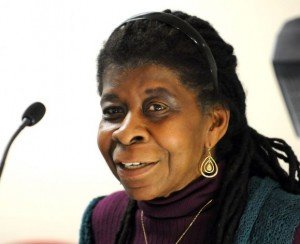Alice Green sees Albany uprising as a call to end structural racism
ALBANY — “Some people call it rioting,” said Alice Green of the melee in Albany Saturday night. “From our perspective, it’s not. It was an uprising.”
Green is the founder and executive director of the Center for Law and Justice in Albany. Its motto is from Frederick Douglass: If there’s no struggle, there’s no progress.
Green’s great-grandmother was born enslaved. “How could you have a society that treats people like animals?” Green asks. “You own them. You own their bodies and you steal their labor. That’s just wrong.”
Green also has a grandmother who was a sharecropper, and a mother and father who lived in the Jim Crow South.
“Blacks have a collective memory,” she says.
America, she notes, has a very long history of violence. For 400 years, violence has been used against people of color, says Green. “Whiteness is a capital … It’s something that gets you what you want and need … You want to hold onto that power,” she says.
“I know firsthand about the incarceration of a lot of our people … I can’t stand the thought of someone being caged … Prison looks like enslavement to me. I don’t think we need to put people behind bars,” says Green.
She is in the midst of writing a book called “We Who Believe in Freedom.”
Green has been a social worker and a teacher, and earned a doctorate degree in criminal justice and three master’s degrees — education, social work, and criminology.
The common thread has been finding freedom, not just for individuals, but by working to change what she calls “structural racism.”
The video of George Floyd, a black man being crushed to death by a white Mineeapolis police officer, Green says has grasped the attention of people around the world.
“What are we doing to each other?” they are asking.
“African Americans have been experiencing this for a very long time,” Green says. She points up the symbolism of having a knee put in a place that chokes the air and life out of someone.
Green was there in the midst of the uprising in Albany on Saturday night. Bricks were hurled. Windows were smashed. Vehicles were burned.
Green said she does not condone violence.
People connected and understood what it meant to be one of the group, what it meant to suffer so much, she said.
“They were saying: We need to be heard.” Green said it was an opportunity for people to express anger and mistrust.
“If we hear that, it will allow us as a community to think: How do we get beyond white supremacy?”
Racism, Green says, is in all of our institutions: criminal justice, education, health care, and employment.
“The virus has shown us what happens when people do not have access to good health care,” she said. In Albany and throughout the nation, a disproportionate number of African Americans have died of COVID-19.
People often think of racism as an individual act, Green says, but it is far more insidious than that, ingrained in our institutions.
The Center for Law and Justice took a survey last year of 250 Albany residents and found, among other things, that close to half of the blacks who answered strongly disagreed that Albany practices effective community policing while just over a quarter of whites said they agreed it does.
The survey found that the community distrusted both the police and the district attorney and that there was anger about police brutality after a police shooting left 19-year-old Ellazar Williams paralyzed, Green said.
The report, “Structural Racism and Public Safety in Albany,” made 19 recommendations for change but “the powers that be dismissed our report,” said Green.
Every other week since the end of April, the center has asked four Albany leaders — Mayor Kathy Sheehan, Police Chief Eric Hawkins, District Attorney David Soares, and Common Council President Corey Ellis — questions about structural racism and community policing in Albany and posted both the questions and the answers on its website.
The core of the problem, says Green, is how our systems are constructed to treat people differently, often based on racial stereotypes. “Our society has come to believe blacks are inherently criminal,” says Green.
In the fall, the center will present a symposium to define racism and community policing. The heart of community policing, Green says, is having a working relationship between the community and the police department. It’s an equal partnership, she stresses.
“We identify problems in the community and work on developing solutions so the whole community is safe,” says Green. “That’s my police department. I pay taxes.”
Transparency is key, she says, so the center has advocated for doing away with 50-A, which keeps police disciplinary records from the public.
Derek Chauvin, the officer accused of murdering George Floyd, Green says, had been disciplined 18 times, and information like that should be known in the community.
“We need to be doing this together,” says Green. “The police department should not be seen as the highest authority in the land.”
Asked about assertions by Albany’s police chief and mayor as well as Albany County’s sheriff that much of the violence on Saturday night was caused by outsiders, Green said she was bothered by Chief Hawkins saying a couple of days earlier that the Albany Police had a strong relationship with the community.
He dismissed the survey and based his information on anecdote, she said. “That’s another way of dismissing the reality of structural racism,” Green said. “He was saying people in the community are happy … It had to come from somewhere else.”
“I was there,” said Green of being in the midst of the uprising on Saturday night. Green said she heard people saying they were angry with the police department and relating “terrible experiences” they or their families had had. Lots of people from the community voiced opposition, Green said.
“The chief was not there. The mayor was not there. I was there,” Green repeated.
Blaming outsiders, Green says, is another way to escape talking about structural racism. “You change the subject,” she said.
Green said she herself was angry when she watched the video of George Floyd as “the life was being taken out of him.”
Some people have more control, she says, while others feel they have to explode; still others feel totally powerless and have no hope in them that change is going to come.
Green said again that she does not condone violence but that she understands it. Prosecuting someone, she said, is not addressing the real issue.
“I don’t like to see people hurt,” Green said. “I don’t like to see people lose their property. When you have no sense of hope … you have no power.”
She concluded, “People are looking just to be a person and accepted as a person.”
Small acts can give hope, she said, like police officers following Colin Kaepernick’s lead and “taking a knee” during the national anthem to protest police brutality or a police officer in Minneapolis who joined the march against the officer accused of murdering George Floyd.
But, she went on, the change needs to transform institutions. She is heartened by statements Governor Andrew Cuomo has made in the last few days, some of which are similar to recommendations made by the Center for Law and Justice.
She cites changes to 50-A that keep police disciplinary records secret, not having district attorneys handling cases on use of force by local police because of the conflict of interest, and developing national standards on the use of force.
“People can do small things,” she said, putting themselves in someone else’s shoes. There are things each of us can do,” said Green. But she also said, “It’s not going to change overnight.”
Green doesn’t believe it will change in her lifetime.


